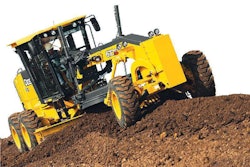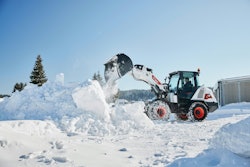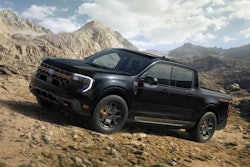More Than Just a Big Dig
Larger backhoe loaders not only offer more strength at either end, but also expanded worksite opportunities beyond digging and loading
By Mike Anderson
Is there really a need for a 17-foot-class backhoe loader? Heck, even a 15-foot-class version could be considered too much.
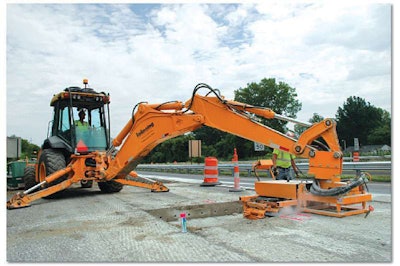 The largest backhoe loader offered by John Deere, the 710 is ideal as a carrier for a dowel pin gang drill on concrete highway patch work, says Kokosing backhoe operator Bill Roeder. Inset: Roeder, right, discusses the attachment’s performance with Minnich Manufacturing’s Mike Sansom.
The largest backhoe loader offered by John Deere, the 710 is ideal as a carrier for a dowel pin gang drill on concrete highway patch work, says Kokosing backhoe operator Bill Roeder. Inset: Roeder, right, discusses the attachment’s performance with Minnich Manufacturing’s Mike Sansom.With every backhoe manufacturer offering extendable sticks, their largest units reach out well past the 20-foot mark. But when it gets to that point, why not just use an excavator?
Veteran equipment operator Bill Roeder is all too willing to share his answers to these questions. In Roeder’s case, he is using a John Deere 710G with a Minnich dowel pin attached to the backhoe end. “We needed a bit bigger backhoe than our previous 17-foot-class backhoe 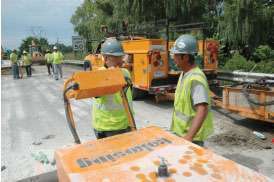
Roader appreciates the backhoe’s manueverability and versatility as a drill carrier in this full-depth patch work. If the gap to be patched is short enough, bottom to top, he can work the backhoe’s boom and stick from one outrigger-secured position and position the attachment to drill on both walls. If it’s a larger patch, upon drilling holes on the closest side, he can quickly reposition the backhoe to drill on the other side before scooting further along the road a few hundred feet to the next cut. “Every thing’s about time out here,” he says. “The faster you can do it, the more money you’re making the company. The more money you’re making the company, the more they’re going to want you to stay on the job.”
Of the four geographic regions defined by the U.S. Census Bureau, the percentage of financed new and used backhoe loaders in the dominant South has increased steadily since 2000, while there’s been a decline of financed sales in the West, according to UCC-1 filings of close to 300,000 total sales. The South Region is comprised of Alabama, Arkansas, D.C., Delaware, Florida, Georgia, Kentucky, Louisiana, Maryland, Mississippi, North Carolina, Oklahoma, South Carolina, Tennessee, Texas, Virginia and West Virginia.
Roeder loves the backhoe loader’s ability to carry the auxiliary compressor for the drill unit as a counterweight on the loader end. He suggested to his supervisors this would be a better solution than the previous practice of using a separate, detached air compressor. “I’m used to putting the compressor right on the front of the backhoe and then you’ve got everything you need right with you,” says the 17-year veteran. “You’ve got storage space for extra bits and drills. That way if something goes bad, you can fix it right now, with less downtime.”
A big performer
The seven manufacturers of backhoe loaders with base dig depths of 15 feet or above (see Machine Matters Roundup on page 20) promote their capabilities in digging, load-and-carry operations and as attachment workhorses. Caterpillar, for example, lists dozens of attachments for both its 15-foot-class 430E and 17-foot-class 450E models.
Case has the most recent model update in this size class, debuting a 15-foot-class 590 Super N model as part of the N Series introduced in late 2010. “We noticed many improvements compared to the M Series machine,” says Barney Kimmel of Williams Excavating, Dillsburg, Pennsylvania. “Both the backhoe and the loader give you more reach and more power. The Power Lift feature on the backhoe is a big deal – you can hang a lot of weight on that boom. We used it for setting big concrete inlet boxes and end walls on a couple of storm sewer projects. It can handle the big shoring boxes, too, which is important if you’re installing long sections of sewer pipe. In Power Lift mode, you can idle the engine down and it’s quiet enough that you can actually talk to someone outside the machine.” Up front, the clamshell bucket earned Kimmel’s praise. “We did some grading and truck loading with the loader bucket – very smooth operation, nice hydraulics.
“We roaded the machine a good bit between jobsites,” he says of the 590-sized N Series backhoe loader. “It rides fine and has enough power to take the hills. And it’s quiet on the road. We really liked the Ride Control feature.”
Another Case user, Dennis Zentner of DRZ Contracting in British Columbia, Canada, says the heavy-lifting ability of the N Series backhoe will “save me from using an excavator.”
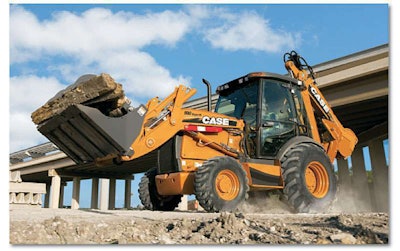 Case’s 15-foot-class 590 Super N model has loader arms that provide greater reach and increased payloads, the company says.
Case’s 15-foot-class 590 Super N model has loader arms that provide greater reach and increased payloads, the company says.Case’s new auxiliary hydraulic system for powering attachments includes standard Flow Control to automatically match the required hydraulic flow to attachments such as hammers, brooms, augers or rakes. Additionally, the hoses are routed inside the boom structure to avoid being hung up and damaged during severe applications. Case offers cab-activated hydraulic backhoe quick-coupler, hand-held hydraulics and loader quick-coupler options.
Fellow CNH brand New Holland, which offers three backhoe loader models with a standard dig depth of 15 feet or above, offers a hydraulic circuit that can be used with a mechanical quick-attach system or an electro-hydraulic quick coupler for fast hookup to a similar wide range of attachments.
With its J-Series, John Deere introduced the optional Total Machine Control (TMC) package for certain models, including the 15-foot-class 410J. Without forgoing any of the backhoe’s consistent low-effort response, operators can select any of three backhoe hydraulic speeds: fast for up to 20-percent quicker cycle times; medium for normal digging; and slow for craning objects and digging in confined spaces or around existing utilities.
JCB now offers a combined hammer and bidirectional auxiliary circuit to provide low and high flow across all 3CX and 4CX machines, including the 15- and 17-foot models. This makes the different JCB backhoe loaders compatible to more attachments, says the company, which now also offers a 29-foot hose reel on the hand-held tool circuit for use of tools alongside the carrier. This eliminates the need for a separate power pack … and further lends credence to Ohio operator Bill Roeder’s claims that a well-equipped super-sized backhoe loader can do so much more than simply dig and load.
MACHINE MATTERS ROUNDUP
CASE
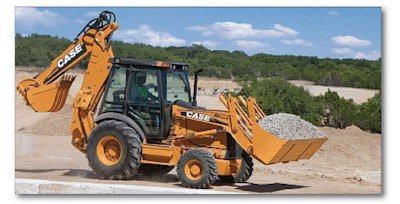
CATERPILLAR
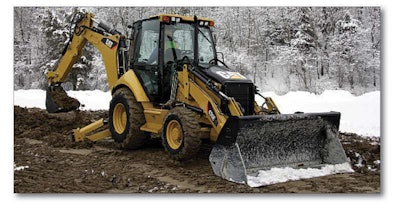 430E IT
430E ITIn the 15-foot backhoe loader class, Caterpillar offers a choice of front linkages. The 430E IT model’s “integrated toolcarrier” linkage version provides higher breakout forces and parallel lift for material handling and loading applications. The standard 430E has a single tilt linkage primarily for backfilling and truck loading. Available front-end work tools beyond a range of buckets include brooms, rakes, forks and snow plows. At the back end, Caterpillar’s curved excavator-style boom provides additional clearance over obstacles while digging a trench or loading a truck, and the narrow design enhances the operator’s view to the bucket and work area throughout the operating range. A single-pin bucket linkage results in 205-degree rotation for all backhoe applications. Available work tools include cold planers, augers, hammers and plate compactors. Caterpillar also offers a 17-foot-class backhoe loader, the 450E, available with the optional E-stick that increases boom reach and dig depth by an additional 4 feet. Caterpillar’s excavator-style backhoe joystick controls provide smooth modulation and – absent a traditional rear console – increased legroom and greater rearward viewing for the operator. For product info, visit: cat.com/equipment/backhoe-loaders
COYOTE
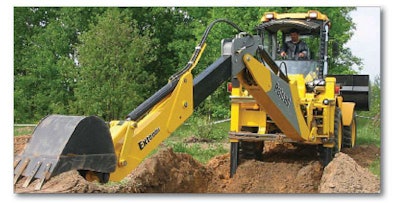
JCB
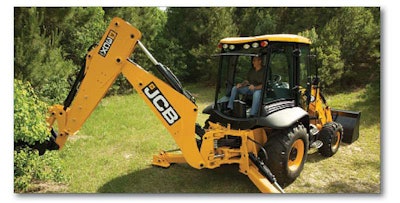
JOHN DEERE
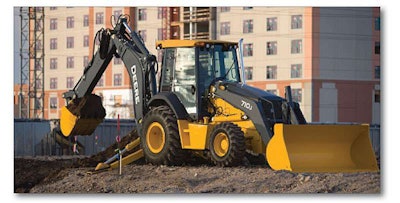
NEW HOLLAND
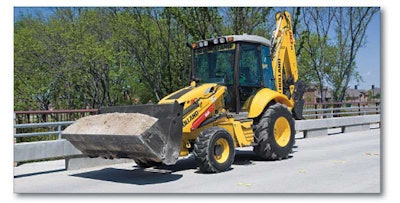 B110B
B110BBy combining one of its smaller base machines with the stick of its standard 15-foot-class backhoe loader, New Holland offers an additional option to the market. “Ideal if you’re looking for added reach with better fuel consumption than larger machines,” the B95B LR long-reach model is a 14-foot-class B95B unit equipped with the B110B’s 15-foot-3-inch arm, says Dave December, marketing manager, New Holland Construction. Powershuttle and Powershift transmission options are newly available on the B95B LR and B110B models. Powershuttle, which retains the use of the right-hand shifter, uses synchronizers for on-the-go shifting between all four gears in forward and reverse. With Powershift, featuring four forward and three reverse gears as well as a kick-down feature, the gear shifting is done with hydraulic clutches. The operator can select either automatic or manual gear shifting modes, and a forward/reverse modulation features three selectable modes. Powershift is also available for the B115B, New Holland’s heavier 15-foot-class backhoe loader with four equal-sized tires. Explaining that not all operators prefer the same control systems, New Holland continues to offer pilot and two-lever controls on the B Series backhoe loaders, says December. For more info, visit: northamerica.construction.newholland.com/family.php
TEREX

For more info, visit: construction.terex.com/en/products/new-equipment/backhoe-loaders/backhoe-loaders-center-mount/index.htm
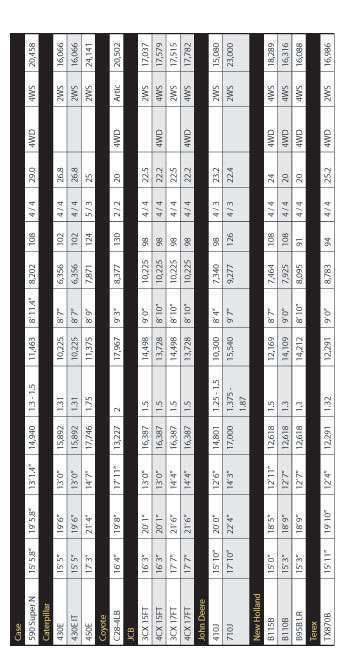
Largest backhoe loaders on the market
Operating weight (lbs)
Steering configuration
Number of drive wheels
Max road speed (mph)
Number of speeds (fwd/rev)
Net power (hp)
Loader lift capacity @ full height (lbs)
Loader dump clearance @ full height discharge (ft/in)
Loader bucket breakout force (lbs)
Loader bucket capacity, SAE heaped (cu yds)
Backhoe bucket digging force (lbs)
Backhoe loading height, standard stick (ft/in)
Max backhoe dig depth, opt. extended stick (ft/in)
Max backhoe dig depth, SAE, standard stick (ft/in)




